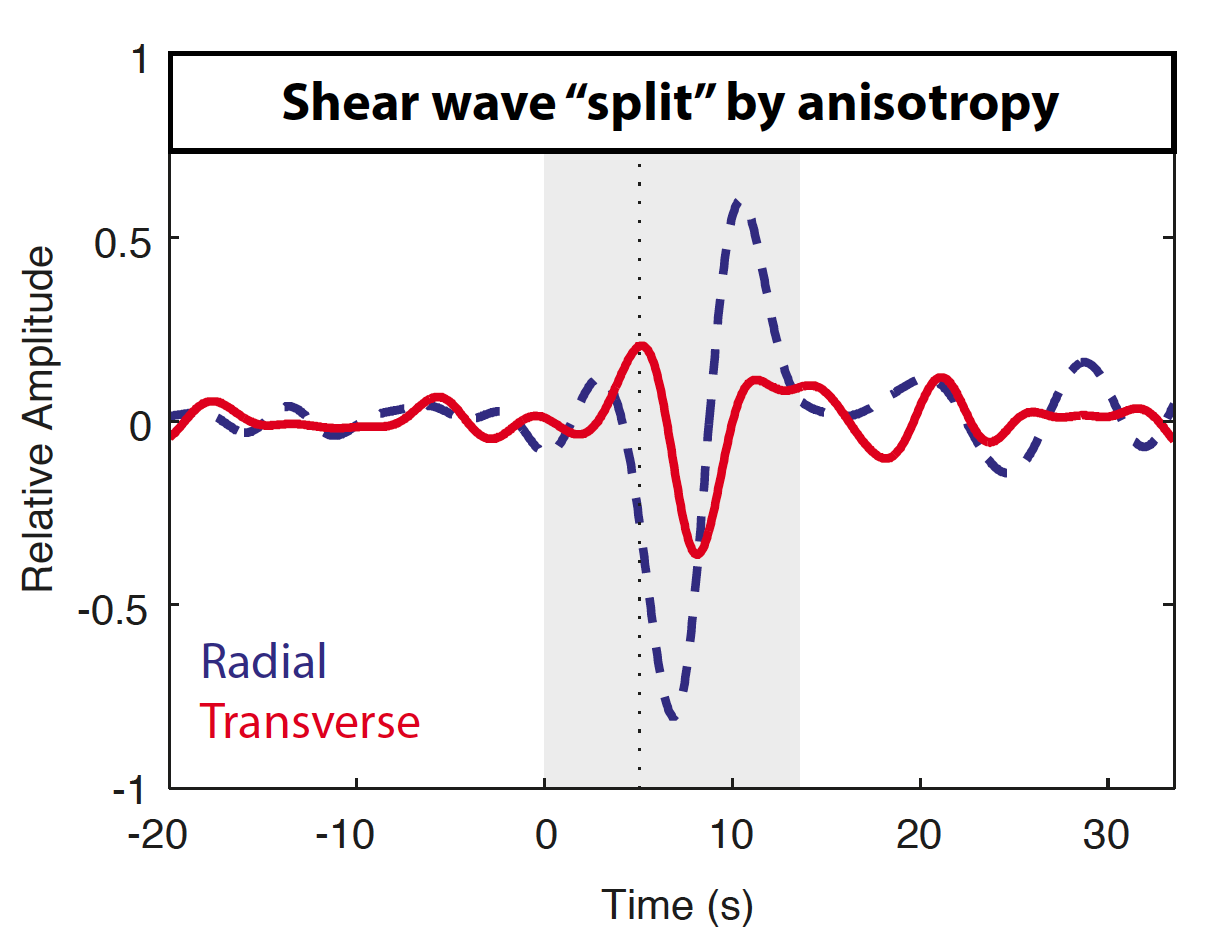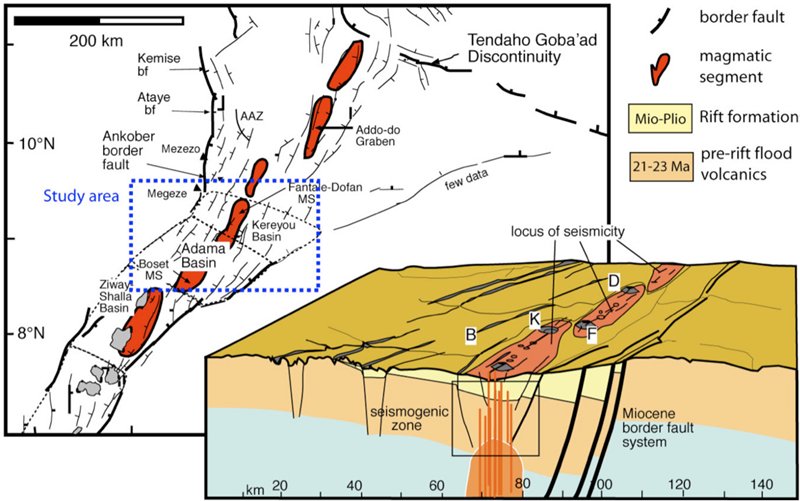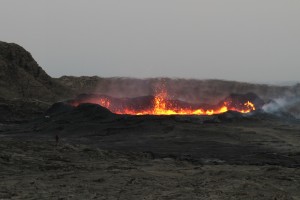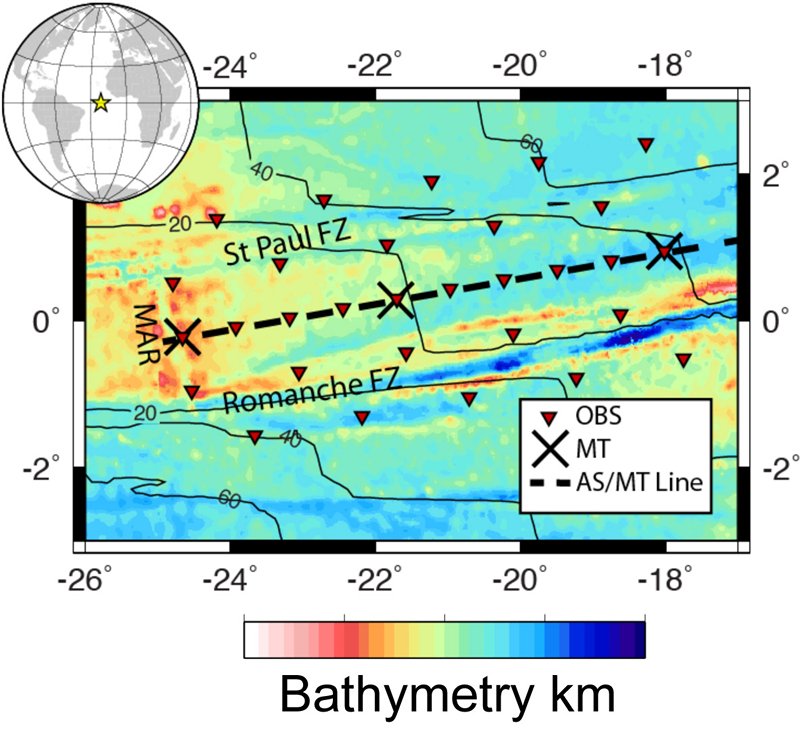Characterising Seismic Anisotropy Beneath Ocean Basins
In the past two decades shear-wave (e.g. SKS) splitting has proven to be an invaluable tool in studying seismic anisotropy and deformation within the Earth’s interior. Such measurements are then used in turn to constrain models of mantle convection wit h implications for plate tectonics, dynamic topography, and the degree of plate-mantle coupling etc. The vast majority of splitting measurements however are made at seismic stations located on land, but oceans cover 70% of the Earth’s surface. In order to better understand the dynamics of our planet on a global scale we therefore need to be able to make observations over the oceans.
h implications for plate tectonics, dynamic topography, and the degree of plate-mantle coupling etc. The vast majority of splitting measurements however are made at seismic stations located on land, but oceans cover 70% of the Earth’s surface. In order to better understand the dynamics of our planet on a global scale we therefore need to be able to make observations over the oceans.
During this project the plan is to develop ways to directly measure the seismic anisotropy beneath oceans by utilizing the distribution of earthquakes and surface reflected phases instead of relying on the distribution of stations.
Key Contact: Caroline Eakin
RiftVolc – Rift volcanism: past, present and future
 In continental rift setting, both effusive and explosive volcanism occur from fissure swarms, volcanic fields and stratovolcanoes. These pose a threat from large magnitude explosions and their associated earthquake activity.
In continental rift setting, both effusive and explosive volcanism occur from fissure swarms, volcanic fields and stratovolcanoes. These pose a threat from large magnitude explosions and their associated earthquake activity.
In rift settings, particularly in the East African Rift, volcanic processes have not been well studied and as a result the associated hazards are highly underestimated. The University of Southampton leads the seismology part of a newly awarded multidisciplinary NERC Large Grant (RiftVolc) to research past and current volcanism and volcanic hazards in the Main Ethiopian Rift.
Key Contact: Derek Keir
Passive Imaging of the Lithosphere-Asthenosphere Boundary (PI-LAB)
Plate tectonics has been a fundamental tenet of Earth Science for nearly 50 years, but questions remain, such as where is the base of the plate and what makes a plate, “plate-like?”
A better understanding of the transition from the rigid lithospheric plate to the weaker mantle beneath has implications for the driving forces of plate tectonics and mantle dynamics. Ocean lithosphere is the ideal place to study the plate; a thermal plate is predicted to increasing in thickness with age, with a gradual transition at its base. Whereas, a compositional plate might be uniformly thick, ~60 km, with sharp base. If melt weakens the asthenosphere, it may also sharpen the LAB transition. These differences can be mapped using geophysical measurements.
Key Contact: Catherine A Rychert
Active fault kinematics during non-volcanic rifting in East Africa
Global seismic networks document frequent and unusually deep earthquakes in the parts of the East African rift lacking central volcanoes. The deep seismicity means that we can use earthquakes to probe the geometry and kinematics of extensional fault systems through the entire crust, and to understand the distribution of strain between large offset border fault systems and intra-basinal faults.
Key Contact: Derek Keir
Evolution of faulting and magmatism during volcanic rifting in the Ethiopian Rift
Faults, volcanoes and lava flows define the surface morphology of volcanically active rifts. In subaerial settings, such as the East African rift, the formation of these features during earthquakes, magmatic intrusion and volcanic eruption poses a major hazard to populations and infrastructure. This study uses GIS data to investigate how the morphology of volcanic rifts evolves, using the Northern Main Ethiopian Rift as an example.
Key Contact: Derek Keir
Faulting in the Whakatane Graben, New Zealand
A high-resolution, long-time-scale fault activity history of the Whakatane Graben, New Zealand which aims to investigate fault propagation and linkage.
Key Contact: Jonathan Bull
Galicia 3D – Exploring ancient continental breakup west of Spain
The seafloor of the northeast Atlantic Ocean (west of Spain) contains faults that were involved in continental rifting and breakup and the initial opening of the Atlantic Ocean ~125 million years ago. The rift is notable because very little volcanism appears to have accompanied rifting, as observed in many other rifts worldwide.This study aims to image in detail the structures of the rifted Deep Galicia Basin in order to improve our understanding of non-volcanic rifted margins.
Interaction between tectonic deformation and magmatism during volcanic rifting in Afar
The breakup of continents is commonly associated with production of large volumes of molten basaltic rock that either intrude the lithosphere or are erupted at the surface. This study aims to use earthquake and structural data to understand the mechanics of tectonic and magmatic deformation in the Afar region.
Key Contact: Derek Keir
Magmatic and Tectonic History of Iceland’s Western Rift Zone at Lake Thingvallavatn
Thingvallavatn is a lake situated within Iceland’s western rift zone and was formed during deglaciation c. 10 ka BP when the inland ice retreated from the site. This study investigates the interaction between past and present tectonic and magmatic processes in this region.
Key Contact: Jonathan Bull
Sailing Away: Global Seismic Imaging of the Oceanic Plates
Oceanic lithosphere constitutes the bulk of Earth’s tectonic plates and also likely represents the building blocks of the continental lithosphere. This study aims to image the lithosphere – asthenosphere boundary across all ocean basins using 23 years of seismic data.
Key Contact: Mr Saikiran Tharimena (PhD Student), Catherine Rychert
Crustal processes of magmatism and tectonism influence the structure of rift systems, such as arc-backarc systems (e.g., Kermadec Arc, SW Pacific) or continental rifts (e.g., Main Ethiopian Rift, Ethiopia). On a local scale volcanic centres (e.g. Monowai) illustrate the tectono-magmatic interactions, within regional variation of the arc-backarc.
Key Contact: Miss Sarah Wormald (PhD Student), Jonathan Bull
Trans-Haiti: Crustal-scale geodynamics of the Hispaniola boundary in the Caribbean
Active tectonic deformation along compressional and transpressional fault systems that develop in subduction zones pose a major hazard to life and infrastructure. In this project we will image the subsurface structure and seismic activity on two major strike slip faults in Haiti.
Key Contact: Derek Keir

